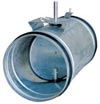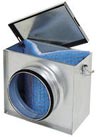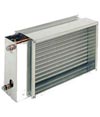
Unlike conditioners, which are not among articles of prime necessity, systems of ventilation are installed in all dwelling and office areas. Availability of systems of ventilation is so important, that their technical requirements have the power of law and are stipulated by the construction rules and regulations.
It is explained with the fact that in case of absence of the ventilation system in indoors concentration of carbon dioxide and other hazardous substances. It has an impact on people’s health, causes headaches, drowsiness and reduction of working efficiency.
The problem may be partially solved by periodical aerating of the area, thus in this case dust, different smells and noise gets into the room along with the fresh air. Also you will have to open and close window or ventlight. All this problems are settled by the system of ventilation.
Whereas estimation of these systems is more complicated than estimation of parameters of an air-conditioner, we will only mention some basic terms, which are used while designing systems of ventilation and acquaint you with typical equipment, which is used for construction of the above-mentioned systems.
Let us remind that selection of ventilating equipment and estimation if necessary capacity should be implemented by specialist of the given field.
Component parts of ventilation system
Composition of the ventilation system depends on its type. More complex and frequently used are input artificial (mechanical) systems of ventilation. We will consider their composition.
Typical input mechanical system of ventilation consists of the following component parts (which are located in the direction of air flow from input to output):
Intake grating
 Outdoor air gets through the intake grating into ventilation system. These gratings as well as other elements of the ventilation system may be of round and square shape. Intake gratings have not only decorative function but also they protect the ventilation system from rain drops and other foreign objects.
Outdoor air gets through the intake grating into ventilation system. These gratings as well as other elements of the ventilation system may be of round and square shape. Intake gratings have not only decorative function but also they protect the ventilation system from rain drops and other foreign objects.
Air valve
 This valve prevents outdoor air from getting into the room while the ventilation system is turned off. The air valve is a very necessary detail especially in winter, as without it cold air and snow with get into the room. As a rule, input systems of ventilation have valves with an electric drive, which allows completely automatic operation of the system – while switching on the ventilation (and calorifer) the valve opens and while switching off – closes.
This valve prevents outdoor air from getting into the room while the ventilation system is turned off. The air valve is a very necessary detail especially in winter, as without it cold air and snow with get into the room. As a rule, input systems of ventilation have valves with an electric drive, which allows completely automatic operation of the system – while switching on the ventilation (and calorifer) the valve opens and while switching off – closes.
Filter
 Filter is necessary for protection of the system and ventilated areas from dust, fluff and insects. In general one coarse filter is installed, which retards particles over 10 micrometers. If purity of the air is of a high priority it is possible to install additional filters of fine purification (which retards particles up to 1 micrometer) and especially fine purification (which retards particles up to 0,1 micrometer). Coarse filter has a synthetic fibre, for example, acrylic. The filter should be periodically cleaned from dirt and dust, in general not less than once in month. To control contamination of the filter you may install differential pressure sensor, which controls difference between pressures of air on output and input – if contaminated, difference of the pressure increases.
Filter is necessary for protection of the system and ventilated areas from dust, fluff and insects. In general one coarse filter is installed, which retards particles over 10 micrometers. If purity of the air is of a high priority it is possible to install additional filters of fine purification (which retards particles up to 1 micrometer) and especially fine purification (which retards particles up to 0,1 micrometer). Coarse filter has a synthetic fibre, for example, acrylic. The filter should be periodically cleaned from dirt and dust, in general not less than once in month. To control contamination of the filter you may install differential pressure sensor, which controls difference between pressures of air on output and input – if contaminated, difference of the pressure increases.
Calorifer
 Calorifer or air heater is designed for heating the air output from outside in winter period. Calorifer may be water (is connected to system of central heating) or electric.
Calorifer or air heater is designed for heating the air output from outside in winter period. Calorifer may be water (is connected to system of central heating) or electric.
For small inflow devices it is more reasonable to use electric calorifers, as installation of such system demands less expenditures. For big offices (with area over 100 sq.m) it is better to use water heaters, otherwise expenses on electricity will be high. There are methods to decrease expenditures on heating of incoming air. With this aim recuperator should be used: device in which cold incoming air is heated at the account of heat exchange with deaerated air. Of course air flows at this case do not mix.
Ventilator
Ventilator is – foundation of any system of artificial ventilation. It is chosen  considering two main parameters: efficiency, i.e. pumpable air and total pressure. According to construction design ventilators are divided on axial-blow blower (for example – domestic ventilators on “base”) and radial or centrifugal (squirrel cage). Axial ventilators ensure good efficiency but have low total pressure, i.e. if the air flow has some obstacle (long air duct with turns, grating etc.), velocity of air flow is decreasing. That is why in ventilation systems with branched network are used radial ventilators, which are distinguished by high pressure of created air flow. Another important characteristic of ventilators is level of noise and dimensions. This parameters mainly depend on brand of the device.
considering two main parameters: efficiency, i.e. pumpable air and total pressure. According to construction design ventilators are divided on axial-blow blower (for example – domestic ventilators on “base”) and radial or centrifugal (squirrel cage). Axial ventilators ensure good efficiency but have low total pressure, i.e. if the air flow has some obstacle (long air duct with turns, grating etc.), velocity of air flow is decreasing. That is why in ventilation systems with branched network are used radial ventilators, which are distinguished by high pressure of created air flow. Another important characteristic of ventilators is level of noise and dimensions. This parameters mainly depend on brand of the device.
Muffler
 As the ventilator is a source of noise, it always has an installed muffler in order to avoid distribution of noise into air ducts. The main source of noise during the works of ventilator is turbulence of air on ventilator blade, i.e. aerodynamic noises. To reduce such noises acoustical absorbent of particular thickness is used to revet one or several walls of the muffler. As usual acoustical absorbent used for the above-mentioned purposes is silicate cotton, glass fibre etc.
As the ventilator is a source of noise, it always has an installed muffler in order to avoid distribution of noise into air ducts. The main source of noise during the works of ventilator is turbulence of air on ventilator blade, i.e. aerodynamic noises. To reduce such noises acoustical absorbent of particular thickness is used to revet one or several walls of the muffler. As usual acoustical absorbent used for the above-mentioned purposes is silicate cotton, glass fibre etc.
Air Ducts
Upon withdrawal from muffler the processed air flow is ready to be widespread in rooms. For the above-mentioned purposes air duct network, consisting of air ducts, shapes (tee, switches), is used. Main characteristics of air ducts are area of section, form (round or square) and rigidity (there are rigid, semi flexible and flexible air ducts). Air flow in air ducts should not exceed particular value; otherwise the air duct will become source of noise. That is why the area of section is determined by the volume of pumpable air, which means that the volume of air duct is chosen based on calculated value of ventilation and maximal velocity of air.
Rigid air ducts are made of zinc-coated sheet metal and may have round or square form. Semi flexible and flexible air ducts have round form and are made of multilayer aluminum foil. Round form of air duct is achieved by means of twisted steel wire. Such construction is convenient as while transportation and installation the air duct may be folded into a “sleeve”. Disadvantage of flexible air ducts is high aerodynamic resistance, caused by uneven internal surface, that’s why this type of air ducts is used in zones of less extension.
Air dispensers
 Through air dispensers the air from the air duct spreads into the area. As a rule, gratings (round or square, wall-type or overhead) or diffusers (bowls) are used in the capacity air dispensers. Apart from decorative functions air dispensers are used for even dispersion of air flow about the area as well as for individual adjustment of air flow, which is distributed through the air dispenser into the area.
Through air dispensers the air from the air duct spreads into the area. As a rule, gratings (round or square, wall-type or overhead) or diffusers (bowls) are used in the capacity air dispensers. Apart from decorative functions air dispensers are used for even dispersion of air flow about the area as well as for individual adjustment of air flow, which is distributed through the air dispenser into the area.
Systems of adjustment and automation
 The last element of ventilation system is electric service panel, in which in general the system of adjustment of ventilation system is installed in ventilation control system. In general ventilation control system consists only of switch with indicator, which enables turning off and on of the ventilator. But more frequently control system with automatic elements is used, which turns on the calorifer in conditions of low temperature of air flow and surveys filter’s cleanness, manages air valve, etc. Thermostats, humidistats, indicators of pressure etc. are used as indicators of control system.
The last element of ventilation system is electric service panel, in which in general the system of adjustment of ventilation system is installed in ventilation control system. In general ventilation control system consists only of switch with indicator, which enables turning off and on of the ventilator. But more frequently control system with automatic elements is used, which turns on the calorifer in conditions of low temperature of air flow and surveys filter’s cleanness, manages air valve, etc. Thermostats, humidistats, indicators of pressure etc. are used as indicators of control system.
Among used materials are articles of periodicals, articles of employees of firm RFK-climate, also article of specialists in the field of air ventilation.